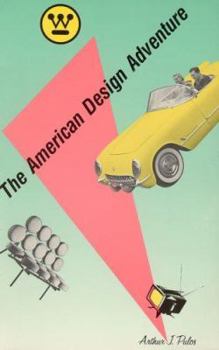The American Design Adventure, 1940-1975
Select Format
Select Condition 
Book Overview
"The American Design Adventure continues the fascinating and detailed examination of industrial design begun by Arthur Pulos in "American Design Ethic." The first volume discussed and illustrated the objects and artifacts, the major designers and schools of design from Colonial times to the 1940s. This second splendidly illustrated volume carries the story into the heroic era of American industrial design, from the 1940s to the 1970s.These were the decades of American industrial design's dominance, when special exhibitions and world fairs made design a subject of national pride. Big business realized the influence that trademarks, packaging, and corporate identity programs could have on their bottom line, and the world of fashion created a consumer demand for name brands and well designed products. Industrial design flourished under the capable hands of Raymond Loewy and Charles Eames, while corporations like IBM, RCA, Herman Miller, and Knoll were sponsors of the great American design adventure.The extraordinary collection of illustrations that Pulos has assembled documents all of these important design trends while evoking the nostalgia of the 50s and 60s when Pop and Rock held sway.Pulos probes all aspects of industrial designers and their work - in education and private corporations, in professional organizations and governmental agencies. He also covers prefabricated housing, graphics, manufactured products from the exotic to the pragmatic, and public sys
Format:Hardcover
Language:English
ISBN:0262161060
ISBN13:9780262161060
Release Date:January 1988
Publisher:MIT Press (MA)
Length:446 Pages
Weight:2.70 lbs.
Customer Reviews
1 rating
The land of iced water
Published by Thriftbooks.com User , 23 years ago
Mark Twain once said that the only thing Americans really had in common with one another was a fondness for iced water. This book offers a much-needed sense of the method behind the multiplicity of American design. It's a pioneering work, even though it has important flaws.Pulos's scholarship is good. However, there is too much about competitions, exhibitions, professional societies, design education and the Museum of Modern Art, even though Pulos is candid about their generally limited impact. Also, the author's political economy is weak. There is uncritical endorsement for Adam Smith, and for design as an instrument of what, in a bizarre Introduction to Adventure, Pulos terms 'barter'. There is a tone of injured, protectionist sensitivity whenever imports from Europe rear their head.'Building the World of Tomorrow', the New York World's Fair of 1939-40, starts us on a brilliant survey of dreams and realities in the early 1940s. Of dreams there were plenty: Henry Dreyfuss, Raymond Loewy, Donald Deskey, Russel Wright and the entirely dotty Norman Bel Geddes, designers to the Fair and to much of mid- century America, were obsessed with science fiction futures. Dreyfuss, who earlier did the Bell telephone, now tried space-age evening dresses for Vogue. As for Bel Geddes, his highly popular Futurama exhibit, a 1960 USA spanned by 14-lane motorways, caused a massive furore.Soon realities crowded in. Pulos covers the Jeep swiftly and then turns in a remarkable passage on US designers and the war effort. Dreyfuss, Loewy and Walter Dorwin Teague, he mentions, designed strategy rooms for the Joint Chiefs of Staff, and Dreyfuss did 13-foot globes for FDR, Churchill and Stalin to plan battles on. Loewy was consultant to the Office of Strategic Services, predecessor of the CIA, in a mysterious-sounding Department of Visual Presentation. Teague won a citation from the Navy for his work in ordnance. Bucky Fuller did Dymaxion Deployment Units for use by the armed forces in the Pacific and the Persian Gulf. Charles Eames, as is well known, did wooden splints for the Navy, while Eliot Noyes met Tom Watson Jr, later his client at IBM, in the Pentagon's planes department. And Bel Geddes ? His chess-like wargame panoramas for the military included, Pulos notes, 'a number of pre-invasion models for events that never occurred, such as a battle of Gibraltar, landings on the north coast of Germany, and a tank battle in the USSR'. Pulos coasts through all this with finesse. His sketches of less prominent designers are exemplary. He shows how Durez plastics and Libbey-Owens-Ford glass, taking advantage of their products' popularity during the shortages of war, organised utopian 'kitchens of the future' for an admiring public whose hopes were later dashed. He deals well with wartime trailer homes, late-1940s prefabricated and Levitt houses, and with what he terms the 'exotic' early-1950s influence of Scandinavian furniture. Pulos's pictures, despite b & w, are fine. He a






